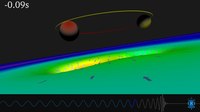
Photo from wikipedia
The sensitivity of current and planned gravitational wave interferometric detectors is limited, in the most critical frequency region around 100 Hz, by a combination of quantum noise and thermal noise. The latter is… Click to show full abstract
The sensitivity of current and planned gravitational wave interferometric detectors is limited, in the most critical frequency region around 100 Hz, by a combination of quantum noise and thermal noise. The latter is dominated by Brownian noise: thermal motion originating from the elastic energy dissipation in the dielectric coatings used in the interferometer mirrors. The energy dissipation is a material property characterized by the mechanical loss angle. We have identified mixtures of titanium dioxide (TiO_{2}) and germanium dioxide (GeO_{2}) that show internal dissipations at a level of 1×10^{-4}, low enough to provide improvement of almost a factor of 2 on the level of Brownian noise with respect to the state-of-the-art materials. We show that by using a mixture of 44% TiO_{2} and 56% GeO_{2} in the high refractive index layers of the interferometer mirrors, it would be possible to achieve a thermal noise level in line with the design requirements. These results are a crucial step forward to produce the mirrors needed to meet the thermal noise requirements for the planned upgrades of the Advanced LIGO (Laser Interferometer Gravitational-Wave Observatory) and Virgo detectors.
Journal Title: Physical review letters
Year Published: 2021
Link to full text (if available)
Share on Social Media: Sign Up to like & get
recommendations!